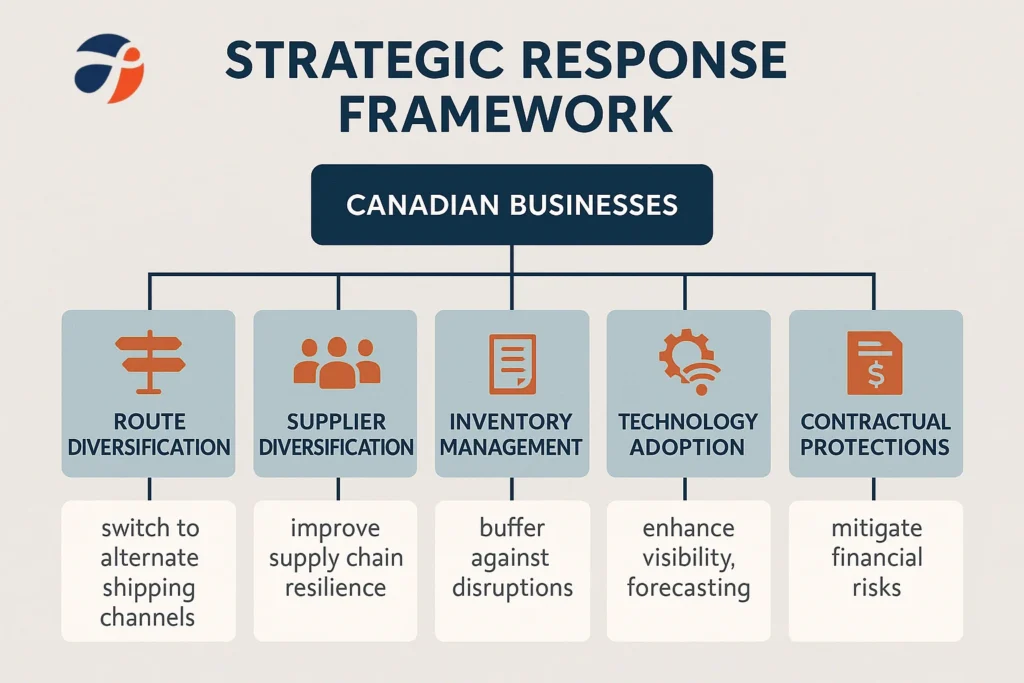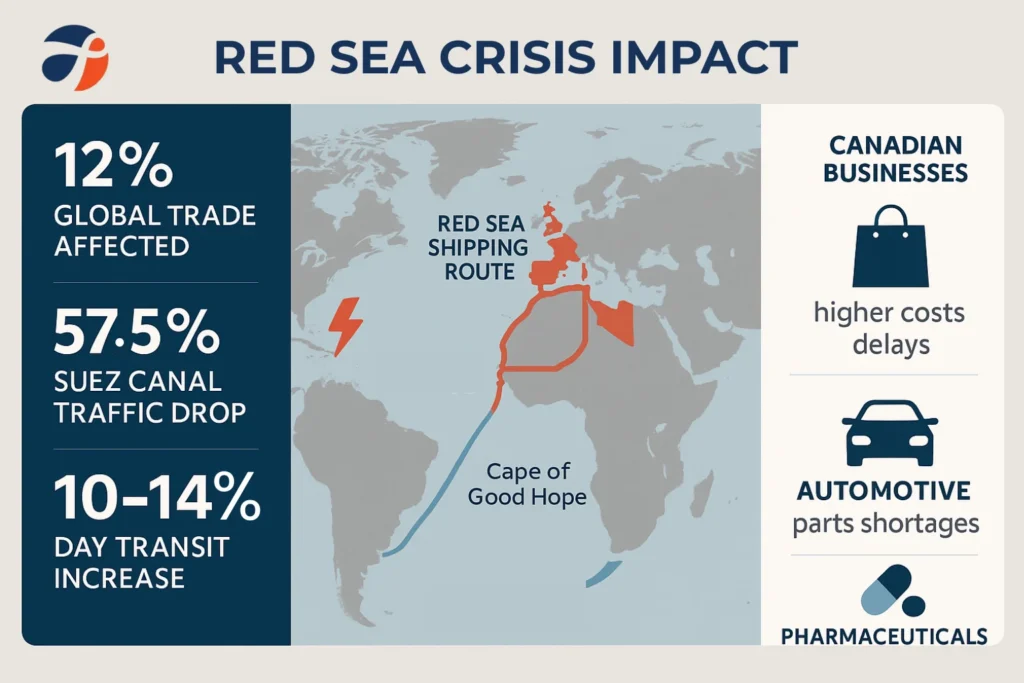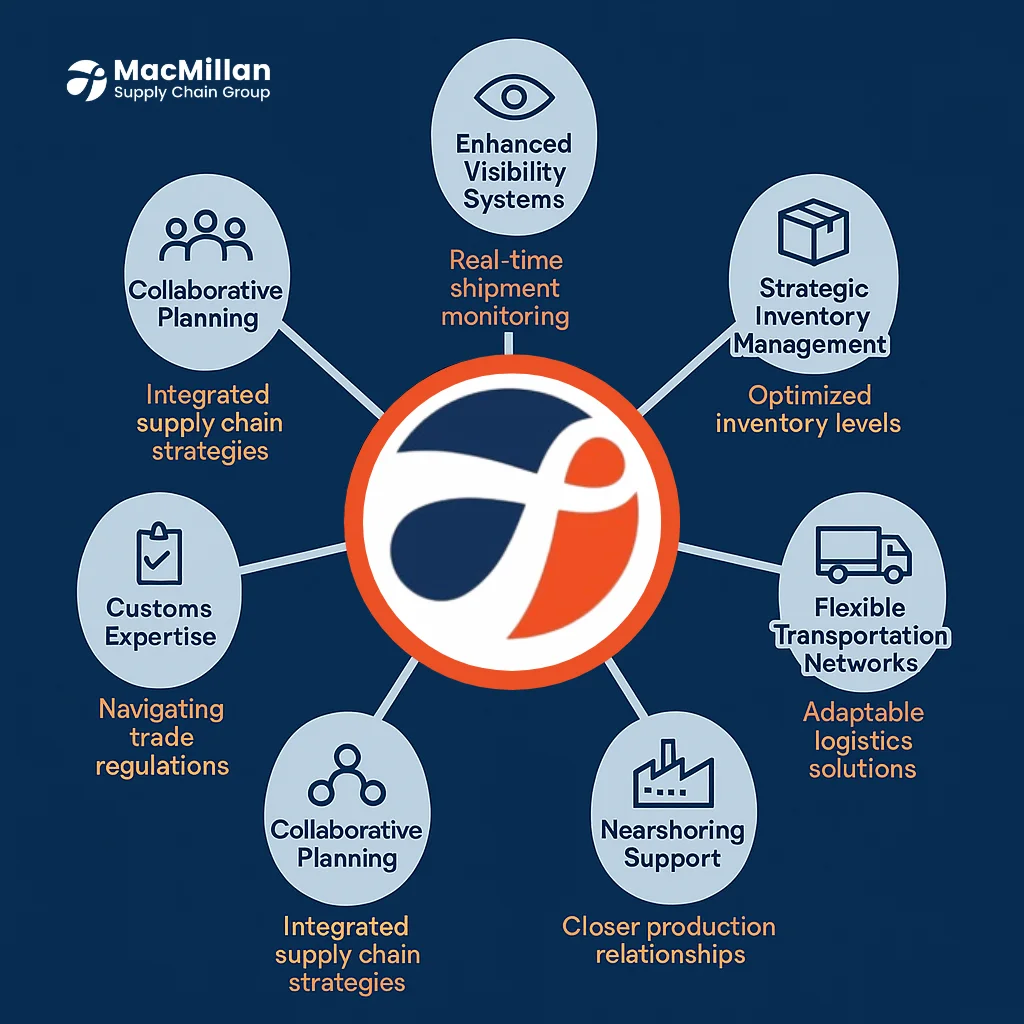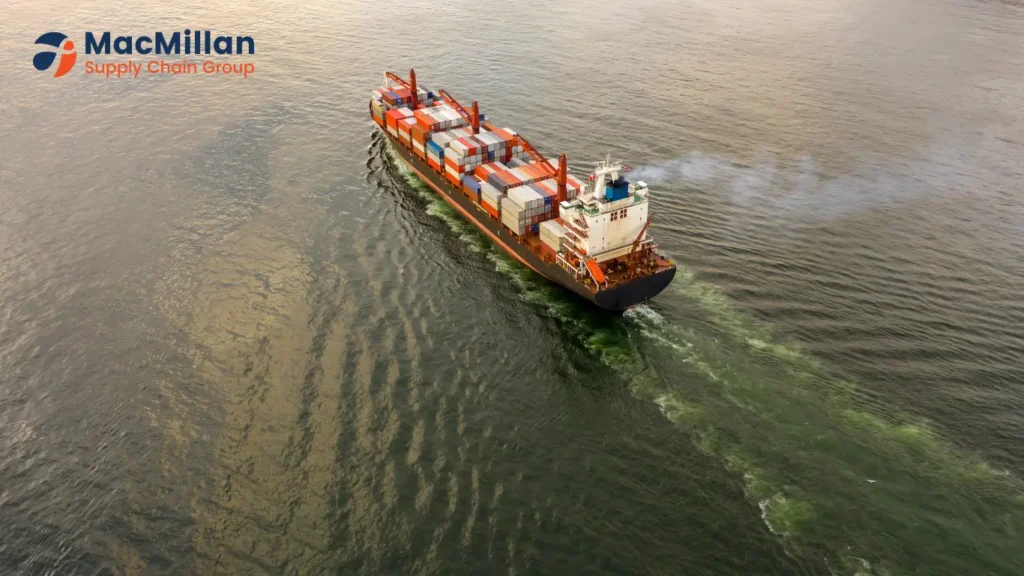Since late 2023, the Red Sea’s been in turmoil, not weather-wise, but politically. Houthi rebel attacks on cargo ships have basically turned one of the world’s busiest trade routes into a no-go zone. So, what does that mean? Longer shipping times, steeper costs, and a whole lot of headaches for businesses across the globe — yes, even up here in Canada.
Retailers are scrambling to restock. Auto manufacturers are battling parts delays. And electronics? Good luck finding certain components on time. This article breaks down how the Red Sea crisis is rippling through global trade routes, what that means for Canadian businesses, and most importantly, what you can do about it.
Introduction:
Let’s take a moment to go back. Houthi militants have been attacking the Bab al-Mandab Strait, a narrow waterway that connects the Red Sea to the Gulf of Aden, more frequently since October 2023. We are discussing drones, missiles, and attempts at hijacking. These are the kinds of stuff that makes major shipping companies say, “Yeah, let’s take the long way.”
And by “long,” we mean really long. Instead of sailing through the Suez Canal and up into Europe, ships are now detouring around the southern tip of Africa. That adds 10 to 14 days of travel. That might not sound like much on paper, but in supply chain time. That’s a lifetime.
To give you an idea of how serious this is, Suez Canal traffic has dropped more than 50% — from 4 million metric tons to 1.7 million. And every one of those missing ships has ripple effects: higher fuel costs, congested ports, delays, and tighter inventory all around.
So yes, it’s halfway across the world, but for Canadian businesses, it hits close to home.

Understanding the Red Sea Crisis
You might be thinking, “But we’re not even near the Red Sea.” True, but we’re deeply tied to the global flow of goods. And when a major artery gets blocked, everything backs up.
Retailers are having a rough time keeping shelves stocked, especially for seasonal items. Some are missing windows entirely and having to either markdown late winter gear or stash it for next year. A few are even flying in goods at crazy costs just to keep customers happy.
Automotive manufacturers are in a jam too. Many operate on just-in-time delivery systems. One delay in a single part can halt an entire assembly line. A major parts supplier in Ontario reported having to switch to air freight to avoid shutting down a plant (and paid five times the normal cost to do it).
Food and specialty importers aren’t off the hook either. Coffee, spices, international delicacies a lot of it comes through affected routes. Prices are climbing, and shelf lives are shrinking thanks to longer voyages.
The point is, this isn’t some abstract global issue — it’s already showing up in Canadian boardrooms, warehouses, and storefronts.
Supply Chain Disruptions Impacting Canadian Businesses
Some industries are feeling the squeeze more than others. Here’s how it’s shaking out:
- Retail: The just-in-time model that once felt so efficient now looks risky. Late deliveries are forcing companies to markdown stock or miss entire seasons. Online sellers are especially feeling the heat as customer patience for delays wears thin.
- Manufacturing: A lot of manufacturers rely on parts from Asia. When those don’t show up on time, production lines stall. A recent survey found 6 in 10 Canadian manufacturers have faced delays since the crisis started. And when time is money, that hurts.
- Pharmaceuticals: While most essential medications have safety stock, some niche or specialty drugs are harder to replace. If disruptions drag on, even those reserves may run low.
- Agriculture and Food Processing: On the export side, grain shipments to markets like the Middle East and North Africa are taking longer and costing more. On the import side, perishable products are arriving late and in smaller quantities.
- Technology: From semiconductors to finished devices, tech companies are feeling the strain. A few Canadian firms have even had to delay product launches because they just couldn’t get components in time.
Canadian Business Strategies for Supply Chain Disruptions
Let’s be real — you can’t stop a missile or open the Suez Canal. But you can adapt. Here’s what smart companies are doing (and what you might want to consider):
- Don’t Put All Your Cargo in One Basket
Diversify your routes. Work with multiple freight partners. Ship critical items by air if you can swing it. Some businesses are even exploring rail options through Central Asia or summer routes across the Arctic (yep, that’s a thing now). - Mix Up Your Suppliers
If you’re heavily dependent on one country — especially one halfway around the world — consider alternatives. That might mean shifting 20–30% of your sourcing to North American suppliers. One Canadian retailer recently pivoted part of its furniture sourcing to Mexico and the U.S. Result? Faster lead times, less panic. - Revisit Your Inventory Game
Just-in-time was great — until it wasn’t. Now, it’s all about balance. Buffer stock is back, but smarter this time. Use data to decide where to build up inventory and where to stay lean. - Use Tech That Tells You More Than “In Transit”
Real-time tracking, predictive analytics, digital twins — these tools can be game-changers. One Canadian electronics company slashed stockouts by a third after implementing a smarter tracking platform. Visibility = power. - Rethink Your Contracts
If your current agreements assume perfect conditions, it’s time for an update. Force majeure clauses, shared-risk models, and flexible delivery terms are now a must. It’s not about pointing fingers — it’s about making things work.

Common Problems with the Red Sea Crisis
- Let’s call it like it is. The Red Sea crisis has created some serious headaches:
- Shipping times are all over the place
- Rates have spiked (some lanes are up 300%)
- Containers are either nowhere to be found or stuck in the wrong port
- Inventory’s either late, too much, or not enough
- You’re flying blind on where your stuff actually is
- Insurance may not cover the full hit
- Everyone’s pointing fingers about who’s responsible
Sound familiar? Yeah, you’re not alone. But that’s where planning and partnerships make a world of difference.
Our Solutions
At MacMillan Supply Chain Group, we’ve seen our fair share of supply chain curveballs. We’re helping Canadian businesses weather this one too. Here’s what we’re bringing to the table:
- Live Tracking That Actually Works – Real-time dashboards that show you exactly where your shipment is, not just “in transit.”
- Smarter Inventory Strategies – We help you figure out what stock actually needs padding, and what doesn’t — so you’re not tying up capital for no reason.
- Multiple Shipping Options – We’re not married to one carrier or route. We build in flexibility so your goods have a Plan B (and C).
- Nearshoring Support – Want to move part of your sourcing closer to home? We help assess suppliers, manage transitions, and integrate them into your supply chain without the drama.
- Customs Know-How – Delays at the border are the last thing you need. Our team keeps things moving smoothly, even when routes shift last-minute.
- Scenario Planning That’s Actually Useful – We get your whole team in the room — ops, sales, finance, the works — and map out real-world contingency plans.
- Tech That Plays Nice with Your Systems – Forecasting tools, optimization software, visibility platforms — we’ll help you stitch it all together so you can make smarter calls faster.
Bottom line? We’re not here to slap a band-aid on the problem. We help build supply chains that can take a hit and keep moving.

How Canadian Businesses Can Implement Solutions
If the Red Sea crisis is giving your business more anxiety than your year-end audit, here’s how to begin:
- Map out your risk zones: What products or components rely on vulnerable trade routes?
- Decide what matters most: What’s critical to your bottom line? Start there.
- Plan in phases: Tackle immediate fires first, then start building long-term changes.
- Loop in your full team: This isn’t just a logistics problem. Finance, sales, ops, everyone has a stake.
- Stay transparent with your partners: Communicate, communicate, communicate.
- Ask for help if you need it: That’s where we come in.
Final Thought
The Red Sea crisis isn’t just another blip, it’s a wake-up call. But with the right moves, Canadian businesses can come out of this not just surviving, but stronger. More agile. More resilient.
If you’re ready to rethink how your supply chain works and make it work better. MacMillan Supply Chain Group is here to help. Let’s turn disruption into opportunity.
Let’s talk.
FAQS
While it's difficult to predict with certainty, maritime security experts suggest the situation could persist for several months or even longer. The underlying geopolitical tensions driving the crisis remain unresolved, and international naval operations have had limited success in deterring attacks. Canadian businesses should prepare for disruptions to continue throughout 2024 and potentially beyond, making long-term resilience strategies essential.
Shipping costs have risen significantly, with container rates from Asia to North America increasing by 30-50% on average since the crisis began. Some specific routes have seen even higher increases. These costs fluctuate based on demand, fuel prices, and available capacity. Canadian businesses should budget for continued elevated shipping expenses and consider strategies like contract negotiations or consolidated shipments to manage these costs.
While air freight offers faster transit times, it's typically 4-6 times more expensive than ocean shipping, making it impractical as a complete solution for most businesses. A more balanced approach involves using air freight selectively for high-value, time-sensitive, or critical items while accepting longer lead times for bulkier, lower-value goods. This hybrid strategy helps manage costs while maintaining supply for essential products.
Small businesses can remain competitive by joining buying groups or working with freight forwarders that aggregate demand from multiple smaller shippers. Focusing on niche products, maintaining higher safety stocks of critical items, and emphasizing local sourcing where possible can also help. Additionally, transparent communication with customers about potential delays often leads to greater understanding and loyalty.
Yes, nearshoring offers several advantages including shorter, more reliable supply chains, reduced transportation costs, easier quality control, and lower carbon emissions. The crisis has accelerated many Canadian companies' existing plans to diversify their supplier base closer to home. However, nearshoring requires careful planning, as North American production typically involves higher labor costs and different manufacturing capabilities than Asian sources.
Effective forecasting during disruptions requires adjusting traditional models. Implement safety stock calculations that account for increased lead time variability, use scenario planning rather than single-point forecasts, and review forecasts more frequently than usual. Advanced analytics that incorporate real-time shipping data can significantly improve accuracy compared to historical patterns alone.
Review your cargo insurance policies to ensure they cover extended transit times, rerouting expenses, and potential storage needs if shipments are delayed. Consider war risk insurance for any shipments still moving through high-risk areas. Also evaluate business interruption coverage to protect against financial losses from supply chain disruptions. Work with insurance brokers who specialize in international trade to identify and address any coverage gaps.
Canadian exports face similar challenges to imports: longer transit times, higher shipping costs, and less predictable delivery schedules. Exporters should build these extended timeframes into customer agreements, consider consolidated shipping to manage costs, and explore air freight options for high-value exports. Some Canadian exporters have successfully negotiated shared-risk arrangements with European customers to distribute the impact of increased shipping costs.
The most valuable technologies include real-time visibility platforms that track shipments across multiple carriers and modes, predictive analytics that forecast potential delays, inventory optimization systems that dynamically adjust safety stock levels, and digital collaboration tools that facilitate communication across supply chain partners. These technologies help businesses anticipate problems, respond quickly, and make data-driven decisions during disruptions.
MacMillan Supply Chain Group offers specialized expertise in navigating supply chain disruptions, with established relationships across multiple carriers and routes. Our services include alternative routing solutions, inventory positioning across our Canadian warehouse network, customs facilitation, and strategic consulting. We provide the flexibility, resources, and experience that many businesses lack internally, allowing them to respond more effectively to the Red Sea crisis while maintaining focus on their core operations.




